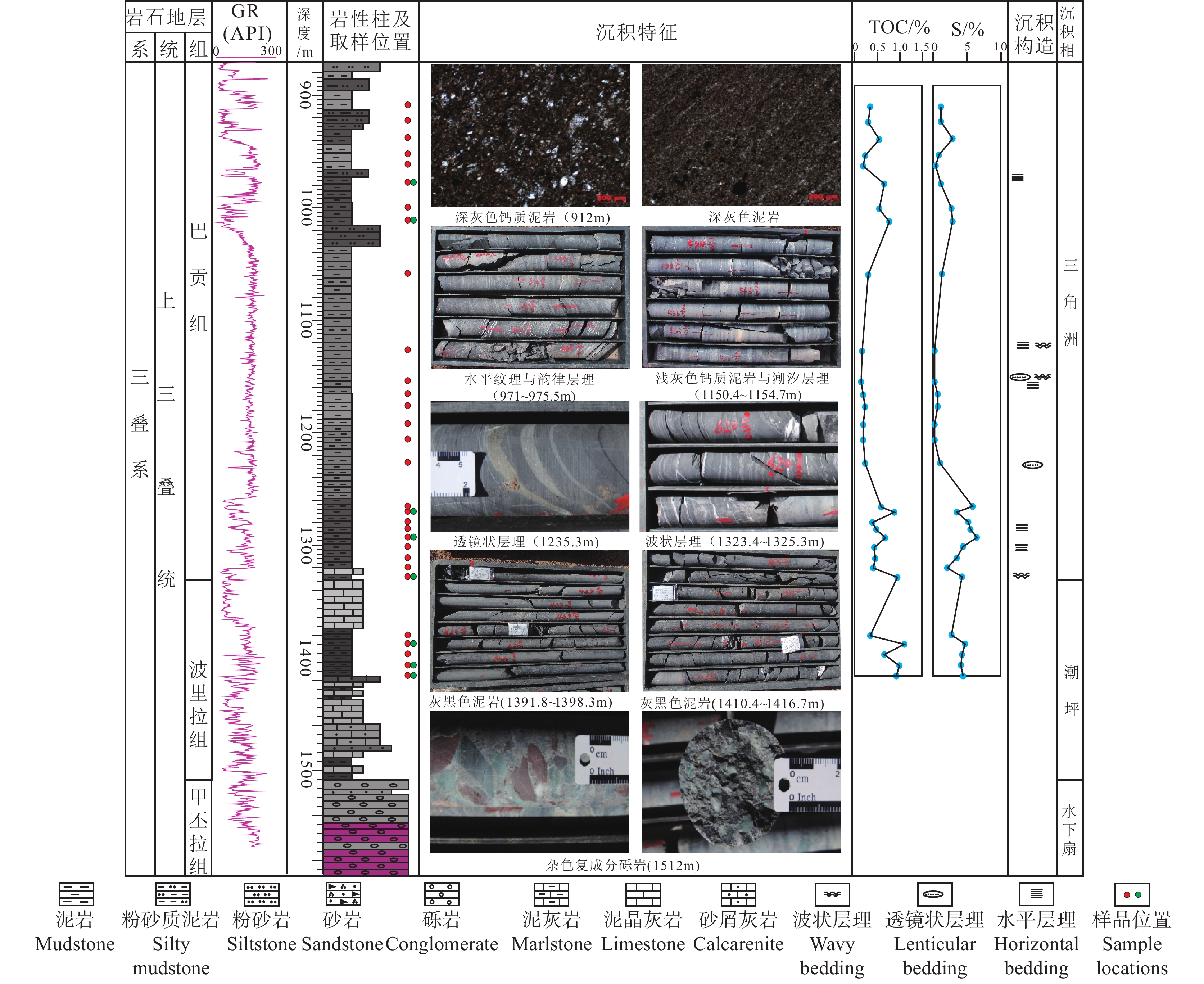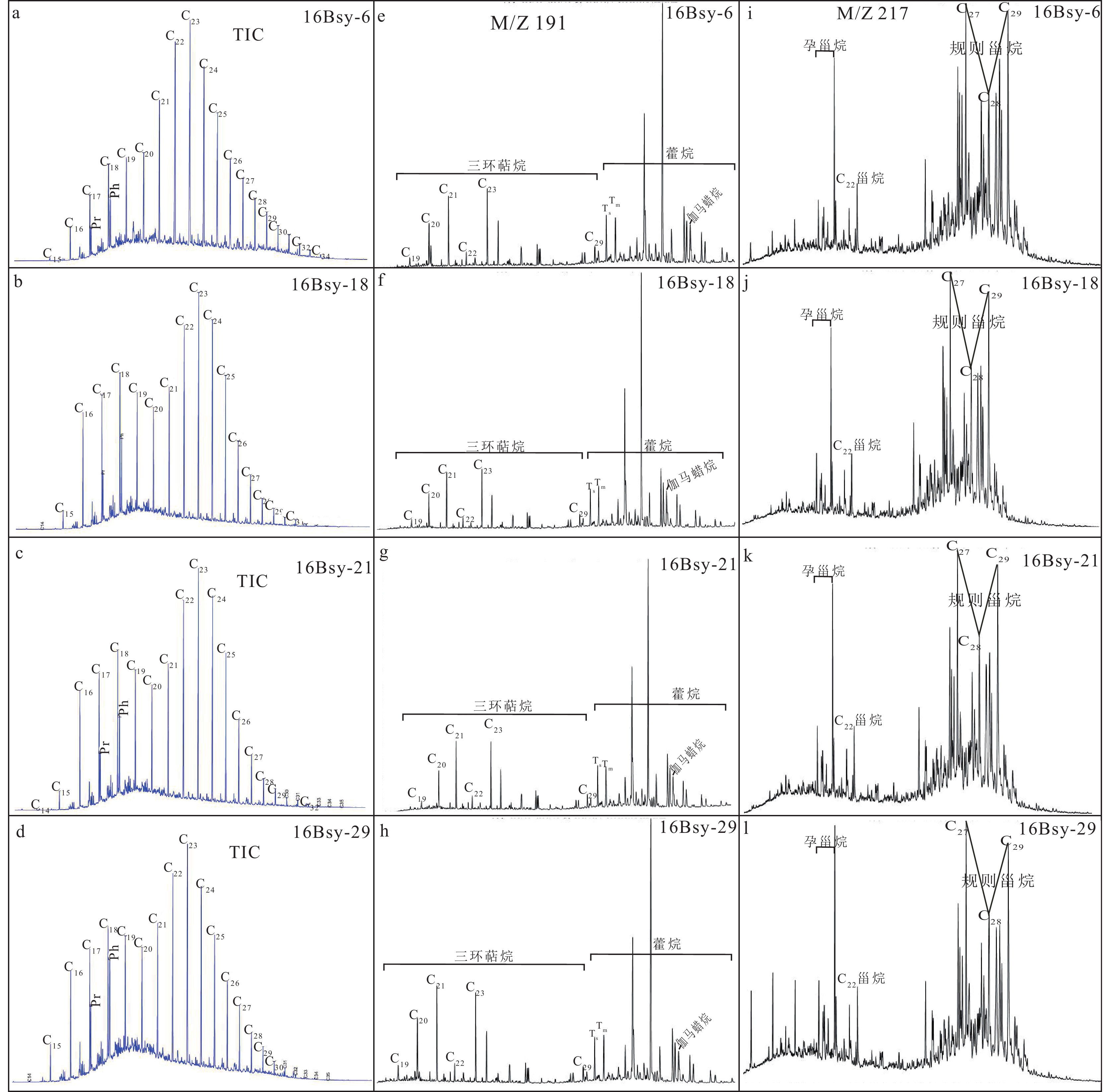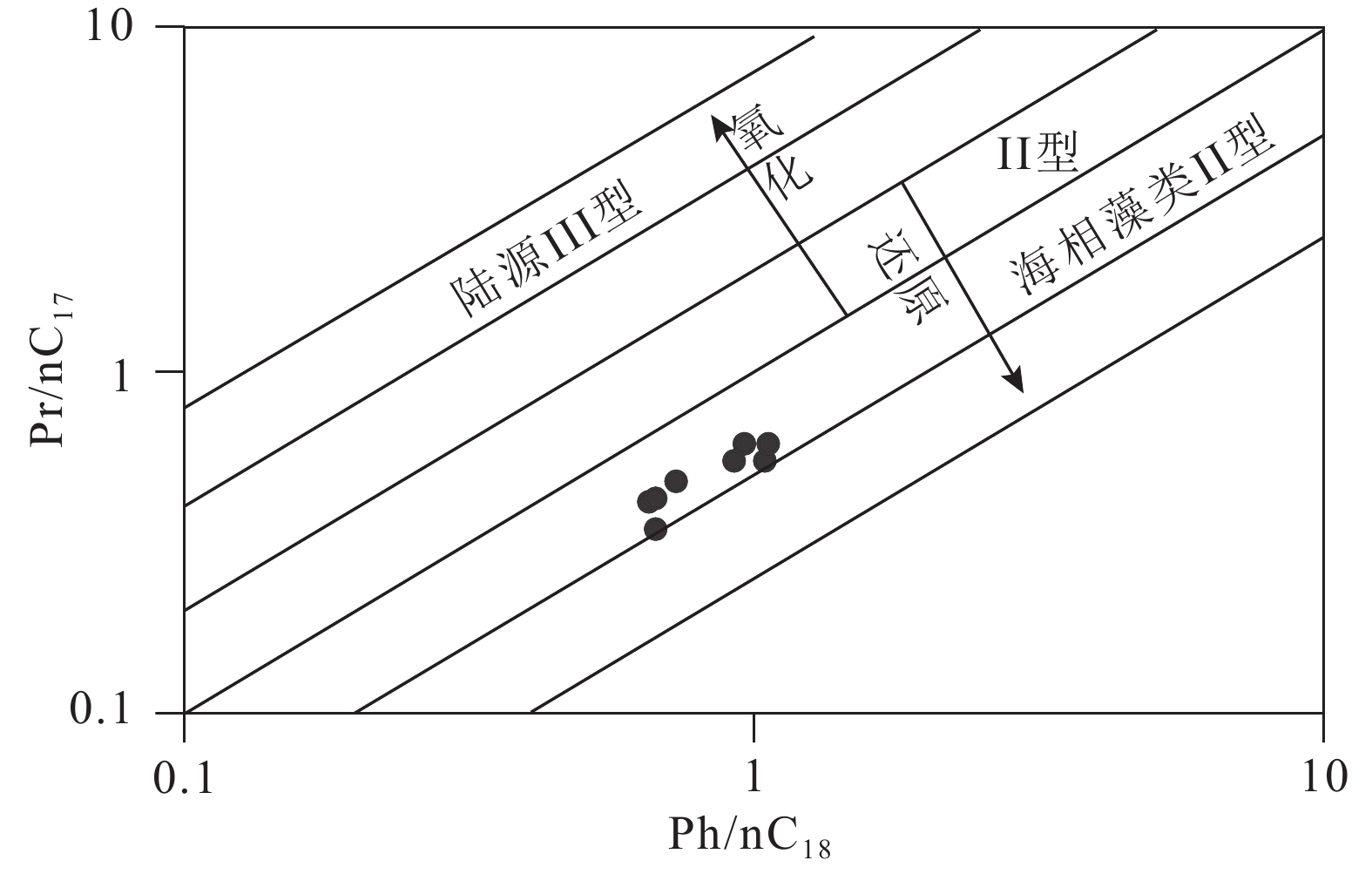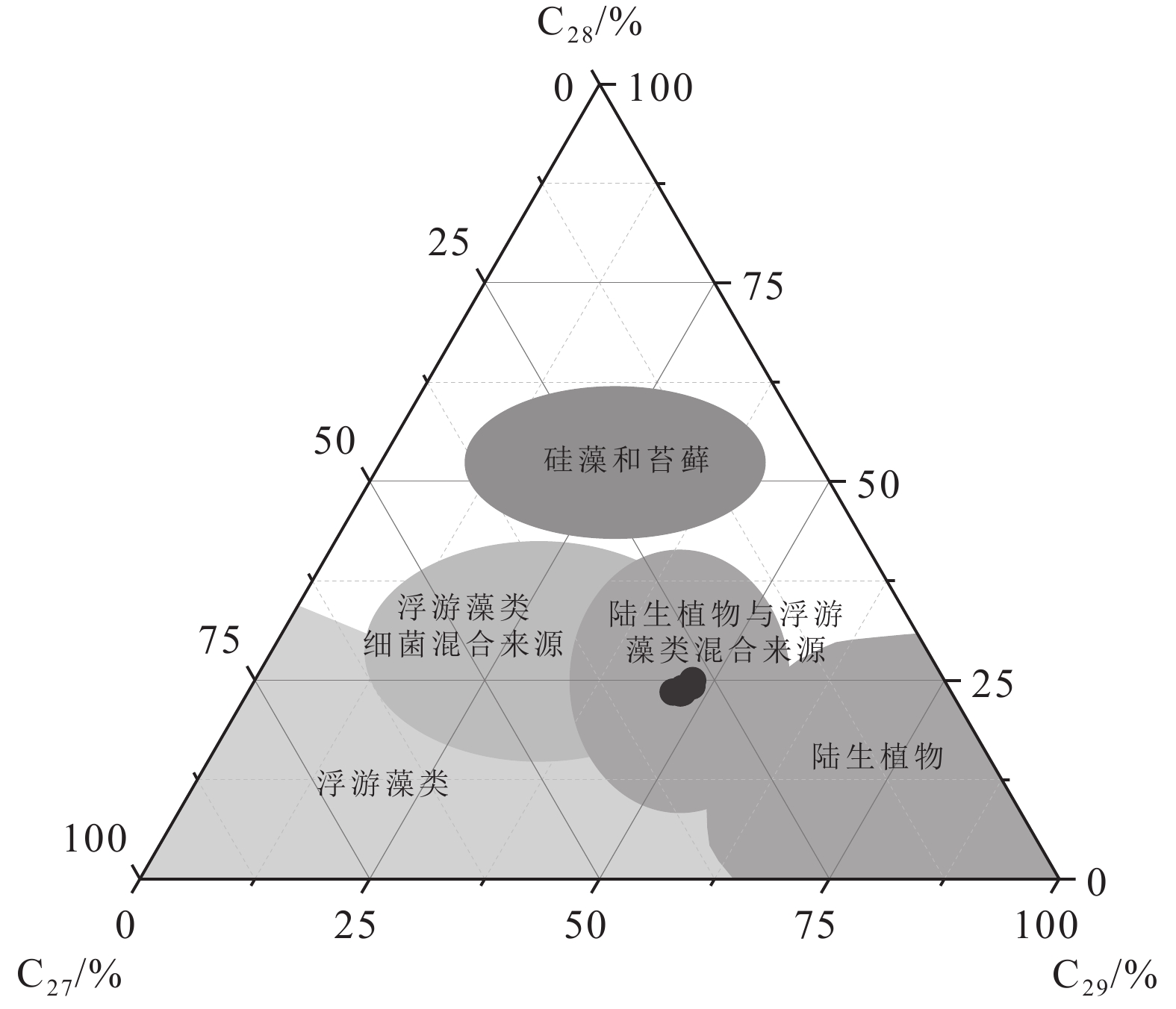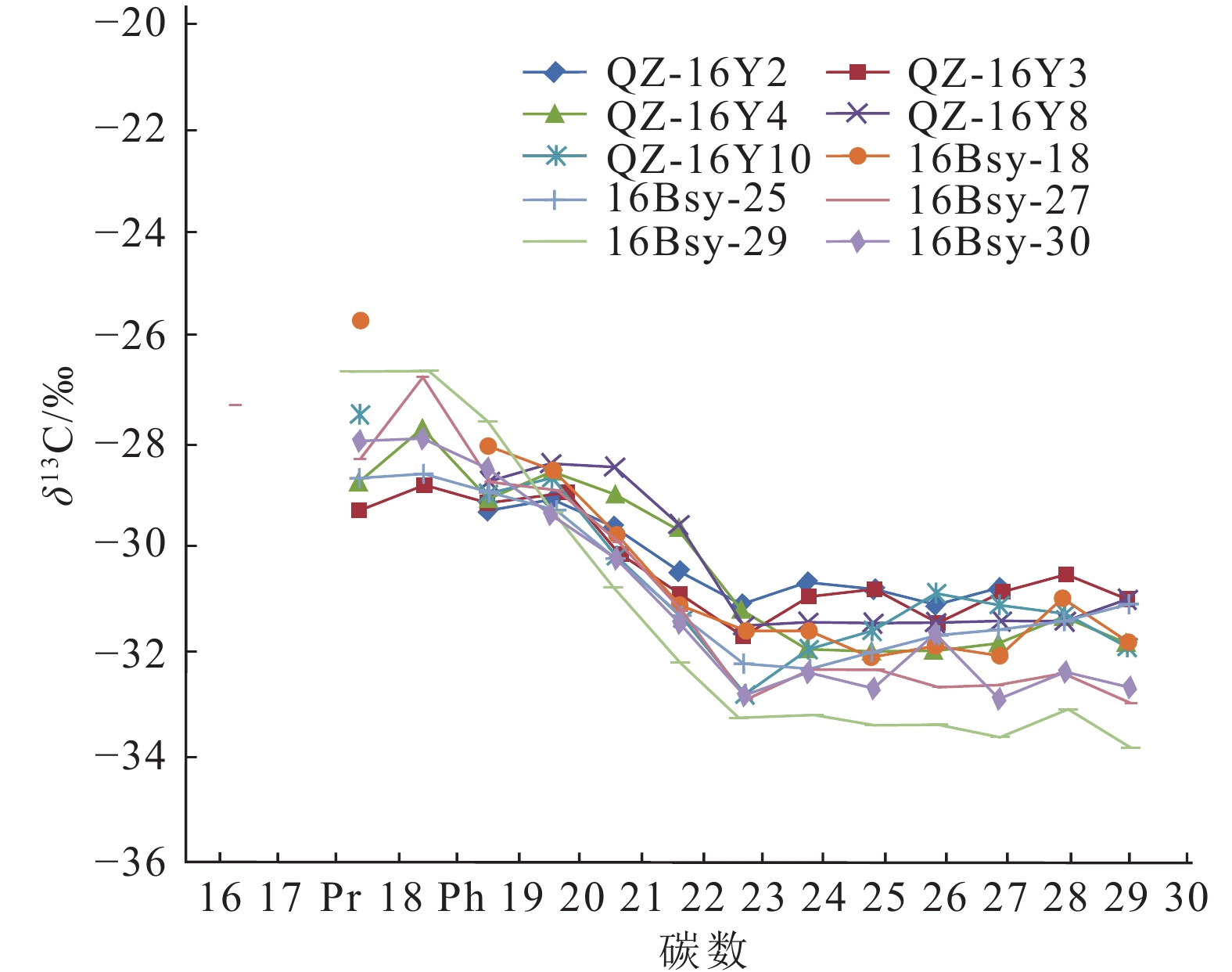Organic geochemical characteristics and hydrocarbon generation potential of Upper Triassic black shales in the North Qiangtang Depression
-
摘要:
研究目的 基于浅地表地质调查认为,上三叠统黑色泥页岩是羌塘盆地最重要的烃源岩。然而,由于缺乏深钻井样品,盆地深部这套烃源岩特征尚不清楚。北羌塘坳陷东部QZ−16井钻遇了迄今为止盆地最深的上三叠统烃源岩,并发现了较显著的气测异常及大量沥青,为盆地深部烃源岩品质研究与生烃潜力分析提供了新的机遇。
研究方法 以QZ−16井上三叠统黑色泥页岩为研究对象,通过有机地球化学测试分析研究,揭示羌塘盆地深部该套烃源岩的有机质丰度、类型、成熟度、来源及其与沥青油苗之间的油源关系。
研究结果 与已有的地质浅钻及地表露头相比,QZ−16井上三叠统黑色泥页岩TOC含量总体较低(0.12%~1.09%,均值为0.47%),但普遍高于II型干酪根的过成熟烃源岩的TOC下限标准(0.3%);氯仿沥青A和生烃潜量(S1+S2)参数可能不能真实反映研究区过成熟烃源岩的有机质丰度;干酪根类型指数(8.75~18.5)、Ph/nC18(0.65~1.06)、Pr/nC17(0.34~0.61)值及C27−C28−C29甾烷特征等表明有机质为低等浮游生物与陆生高等植物的混合来源,为II2型干酪根,且多形成于较强的还原环境;干酪根颜色(棕褐色—黑色)、Tmax(536~602 ℃)、镜质体反射率(Ro=2.44%~2.77%)及生物标志化合物参数表明该套黑色泥页岩有机质热演化程度为过成熟;油源对比参数反映QZ−16井上三叠统沥青油苗与黑色泥页岩之间具有较好的亲缘关系,为自生自储型。
结论 北羌塘坳陷上三叠统黑色泥页岩为过成熟烃源岩,具有一定的生烃潜力,该成果为羌塘盆地烃源岩评价提供了新的参考依据。
Abstract:This paper is the result of oil and gas exploration engineering.
Objective Geological investigations of petroleum potential suggest that the Upper Triassic black shales represent the most significant source rock interval in the Qiangtang Basin. However, the organic geochemical characteristics and hydrocarbon generation potential of these source rocks in the deep basin are still under ongoing research due to the lack of deep drilling activities.
Methods The well QZ−16, located in the eastern part of the North Qiangtang Depression, has encountered the deepest Upper Triassic strata in the basin to date, revealing significant gas anomalies and a substantial amount of bitumen. This provides a new opportunity to enhance the understanding of deep basin source rocks. Here, organic geochemical analyses of the Upper Triassic black shales were conducted to investigate the organic matter quality, quantity, and levels of thermal maturity as well as the oil−source relationship between the source rock and bituminous oil.
Results The TOC content of the Upper Triassic black shales in the well QZ−16 is generally poor to fair organic matter richness, ranging from 0.12% to 1.09%, with an average of 0.47%. These values are higher than the average TOC limit (0.3%) of over−mature source rocks with type II kerogen. The degree of thermal maturity is suggested to be in the over−mature stage based on significantly high Tmax (536−602 ℃) and vitrinite reflectance values (Ro = 2.44%−2.77%). The chloroform asphalt A and hydrocarbon generation potential (S1+S2) may not reliably reflect the organic matter abundance due to the source rocks being in the over−mature stage. Kerogen type index (8.75−18.5), Ph/nC18 (0.65−1.06), Pr/nC17 (0.34−0.61) and C27−C28−C29 sterane characteristics indicate a mixed organic matter source comprising of lower plankton and higher terrestrial plants of Type II2 kerogen. Most source rock intervals were deposited under strongly reducing conditions, exhibiting a brown−black kerogen color, which align with biomarker parameters, indicating that the thermal evolution of the black shale is over mature. The oil source correlation parameters reveal a strong affinity between the Triassic bituminous oil seedling and black shale in the well QZ−16, which is self−generated and self−stored.
Conclusions The Upper Triassic black shales in the North Qiangtang Depression are mature source rocks with certain hydrocarbon generation potential. The results of this study provide a new reference for evaluating source rocks and analyzing hydrocarbon generation potential in the Qiangtang Basin.
-

-
表 1 QZ−16井上三叠统黑色泥岩基础有机地球化学参数
Table 1. Basic organic geochemical parameters of Upper Triassic black mudstones in the well QZ−16
样品编号 TOC S S1 S2 S3 氯仿沥青A/10−6 HI OI Tmax/℃ Ro 16Bsy−1 0.34 1.10 / / / / / / / / 16Bsy−2 0.28 1.11 / / / / / / / / 16Bsy−3 0.53 2.74 / / / / / / / / 16Bsy−4 0.22 0.71 / / / / / / / / 16Bsy−5 0.18 0.30 / / / / / / / / 16Bsy−6 0.64 1.08 0 0 0.20 13.96 0 21 601 2.44 16Bsy−7 0.54 2.62 / / / / / / / / 16Bsy−8 0.76 2.77 0 0 0.18 15.84 0 15 n.d 2.46 16Bsy−9 0.29 1.28 / / / / / / / / 16Bsy−10 0.15 0.10 / / / / / / / / 16Bsy−11 0.12 0.12 / / / / / / / / 16Bsy−12 0.18 0.61 / / / / / / / / 16Bsy−13 0.22 0.66 / / / / / / / / 16Bsy−14 0.17 0.07 / / / / / / / / 16Bsy−15 0.17 0.10 / / / / / / / / 16Bsy−16 0.21 0.95 / / / / / / / / 16Bsy−17 0.57 5.70 / / / / / / / / 16Bsy−18 0.87 3.43 0 0 0.15 19.61 0 13 582 2.54 16Bsy−19 0.37 5.08 / / / / / / / / 16Bsy−20 0.46 5.45 / / / / / / / / 16Bsy−21 0.67 6.31 0 0 0.18 6.66 0 16 536 2.77 16Bsy−22 0.43 4.41 / / / / / / / / 16Bsy−23 0.45 3.45 / / / / / / / / 16Bsy−24 0.40 2.07 / / / / / / / / 16Bsy−25 0.92 4.18 0 0 0.13 5.65 0 9 n.d 2.65 16Bsy−26 0.33 2.56 / / / / / / / / 16Bsy−27 1.09 4.59 0 0 0.18 17.29 0 12 n.d 2.70 16Bsy−28 0.63 4.12 / / / / / / / / 16Bsy−29 0.98 4.08 0 0 0.13 17.88 0 8 602 2.73 16Bsy−30 0.92 4.37 0 0 0.12 13.48 0 10 n.d 2.68 表 2 QZ−16井上三叠统黑色泥岩干酪根显微组分及类型
Table 2. Maceral compositions and kerogen type of Upper Triassic black mudstones in the well QZ−16
样品 干酪根显微组分/% 干酪根
指数干酪根
类型干酪根
颜色壳质组 镜质组 惰质组 无定型腐殖质 无结构镜质体 结构镜质体 丝质体 16Bsy−6 75 10 12 3 18 Ⅱ2 棕褐色 16Bsy−8 70 16 6 8 10.5 Ⅱ2 棕褐色 16Bsy−18 72 6 18 4 14 Ⅱ2 棕黑色 16Bsy−21 68 15 12 5 8.75 Ⅱ2 棕黑色 16Bsy−25 68 10 18 4 9.0 Ⅱ2 棕黑色 16Bsy−27 70 13 12 5 11.25 Ⅱ2 棕黑色 16Bsy−29 76 8 10 6 18.5 Ⅱ2 棕黑色 16Bsy−30 75 10 10 5 17.5 Ⅱ2 棕黑色 表 3 QZ−16井上三叠统黑色泥岩正构烷烃单体碳同位素特征
Table 3. Carbon isotope characteristics of n-alkanes in Upper Triassic black mudstones in the well QZ−16
样品
编号δ13CPDB/‰ C17 C18 Ph C19 C20 C21 C22 C23 C24 C25 C26 C27 C28 C29 16Bsy−18 / −25.7 / −28.1 −28.5 −29.8 −31.1 −31.6 −31.6 −32.1 −31.8 −32.1 −31.0 −31.8 16Bsy−25 / −28.7 −28.6 −28.9 −29.3 −30.3 −31.3 −32.2 −32.3 −32.0 −31.7 −31.6 −31.4 −31.1 16Bsy−27 −27.3 −28.3 −26.8 −28.7 −28.9 −29.9 −31.2 −32.9 −32.3 −32.3 −32.7 −32.6 −32.4 −33.0 16Bsy−29 / −26.7 −26.7 −27.6 −29.3 −30.8 −32.2 −33.3 −33.2 −33.4 −33.4 −33.6 −33.1 −33.8 16Bsy−30 / −28.0 −27.9 −28.5 −29.4 −30.2 −31.5 −32.8 −32.4 −32.7 −31.6 −32.9 −32.4 −32.7 表 4 QZ−16井上三叠统黑色泥岩正构烷烃、类异戊二烯烃、萜烷与甾烷参数特征
Table 4. Characteristics of n-alkane, major isoprenoid, terpanes and steranes parameters of Upper Triassic black mudstones in the well QZ−16
样品编号 16Bsy−6 16Bsy−8 16Bsy−18 16Bsy−21 16Bsy−25 16Bsy−27 16Bsy−29 16Bsy−30 主峰碳 C23 C23 C23 C23 C23 C23 C23 C23 CPI 1.12 1.16 1.3 1.13 1.15 1.15 1.19 1.15 OEP 1.01 1.03 1.03 1.02 1 1.03 1.02 1.04 C21−/C22+ 0.4 0.96 0.78 0.6 0.81 1.13 0.82 0.8 Pr/Ph 0.4 0.47 0.53 0.37 0.51 0.4 0.51 0.47 C24TeT/C26TT 0.66 0.6 0.64 0.71 0.71 0.63 0.67 0.72 ST/H30-35 0.61 0.55 0.43 0.49 0.45 0.43 0.56 0.48 C25TT/C24TeT 1.47 1.66 1.45 1.4 1.43 1.44 1.53 1.38 C21+20TT/C23+24TT 0.96 1.03 1.02 1 1.12 0.91 1.17 1.13 G/C30H 0.17 0.14 0.16 0.13 0.13 0.11 0.12 0.11 Ts/Tm 1.02 0.95 0.85 0.98 0.87 0.82 0.86 0.95 C27/% 28 30 30 29 28 27 29 29 C28/% 24 24 23 23 24 25 23 24 C29/% 48 46 47 47 48 48 47 47 C29ααα20S/(20S+20R) 0.44 0.43 0.45 0.44 0.46 0.47 0.45 0.47 C29αββ/(ααα+αββ) 0.41 0.38 0.39 0.39 0.4 0.4 0.39 0.4 -
[1] Chen Wenbin, Fu Xiugen, Tan Fuwen, Fen Xinglei. 2014. Geochemical characteristics of biomarkers of the Upper Triassic source rocks from Tumengela Formation in Qiangtang Basin of Tibet[J]. Geoscience, 28(1): 216−223 (in Chinese).
[2] Chen Zhijun, Zhang Chunming, He Yonghong, Wen Zhigang, Ma Fangxia, Li Wei, Gao Yiwen, Chen Yiguo, Zhang Huiyuan, Wei Dongtao. 2022. Characteristics and geochemical indication of over−mature source rocks in the Paleozoic, Yingen−Ejinaqi Basin[J]. Oil & Gas Geology, 43(3): 682−695 (in Chinese with English abstract).
[3] Cranwell P A. 1973. Chain length distribution of n−alkanes from lake sediments in relation to postglacial environmental change[J]. Freshwater Biology, 3: 259−265. doi: 10.1111/j.1365-2427.1973.tb00921.x
[4] Didyk B M, Simoneit B R T, Brassell S C, Eglinton G. 1978. Organic geochemical indicators of palaeoenvironmental conditions of sedimentation[J]. Nature, 272(5650): 216−222. doi: 10.1038/272216a0
[5] Ding L, Yang D, Cai F L, Pullen A, Kapp P, Gehrels G E, Zhang L Y, Zhang Q H, Lai Q Z, Yue Y H, Shi R D. 2013. Provenance analysis of the Mesozoic Hoh−Xil− Songpan−Ganzi turbidites in northern Tibet: Implications for the tectonic evolution of the eastern Paleo−Tethys Ocean[J]. Tectonics, 32: 34−48. doi: 10.1002/tect.20013
[6] Eglinton G, Gonzales A G, Hamilton R J, Raphael R A. 1962. Hydrocarbon constituents of wax coatings of plant leaves: A taxonomic survey[J]. Phytochemistry, 1: 89−102. doi: 10.1016/S0031-9422(00)88006-1
[7] Farrimond P, Bevan C J, Bishop A N. 1999. Tricyclic terpane maturity parameters: response to heating by an igneous intrusion[J]. Organic Geochemistry, 30: 1011e1019.
[8] Fu X G, Wang J, Tan F W, Feng X L, Wang D, He J L. 2013. Gas hydrate formation and accumulation potential in the Qiangtang Basin, northern Tibet, China[J]. Energy Conversion and Management, 73: 186−194. doi: 10.1016/j.enconman.2013.04.020
[9] Fu Xiugen, Chen Wenbin, Zeng Shengqiang, Sun Wei, Wang Jian. 2020. Petroleum Geological Characteristics of Qiangtang Basin−Information from Geological Survey Drilling[M]. Beijing: Science Press (in Chinese).
[10] Hou Dujie, Feng Zihui. 2011. Oil and Gas Geochemistry[M]. Beijing: Petroleum Industry Press, 79 (in Chinese).
[11] Kapp P, Yin A, Manning C E, Harrison T M, Taylor M H, Ding L. 2003. Tectonic evolution of the early Mesozoic blueschist−bearing Qiangtang metamorphic belt, central Tibet[J]. Tectonics, 22: 1043.
[12] Li Yong, Wang Chengshan, Yi Haisheng. 2003. The Late Triassic collision and sedimentary responses at western segment of Jinshajiang suture, Tibet[J]. Acta Sedimentologica Sinica, 21(2): 191−197 (in Chinese with English abstract).
[13] Liang Xiao. 2020. The Deep Marine Hydrocarbon Accumulation Process under Complex Tectonic Background in the Northern Segment of Western Sichuan Depression[D]. Chengdu: Chendu University of Technology, 1−152 (in Chinese with English abstract).
[14] Lin Fei, Fu Xiugen, Wang Jian, Song Chunyan. 2023. Mechanism of organic matter accumulation in a marine-terrestrial transitional residual bay environment: A case of Early Cretaceous organic-rich shales in the QiangtangBasin[J]. Geology in China, 50(4): 1093-1106(in Chinese with English abstract).
[15] Liu Zhongrong, Yang Ping, Zhang Guochang, Fan Zhiwei, Han Jing, Tan Fuwen, Zhan Wangzhong, Zeng Shengqiang, Wei Hongwei, He Lei, He Jiale. 2022. Sedimentary model and its implications for oil and gas exploration of Upper Triassic in Northern Qiangtang depression[J]. Sedimentary Geology and Tethyan Geology, 42(3): 465−480 (in Chinese with English abstract).
[16] Moldowan J M, Seifert W K, Gallegos E J. 1985. Relationship between petroleum composition and depositional environment of petroleum source rocks[J]. AAPG Bulletin, 69(8): 1255−1268.
[17] Pang Xiongqi, Li Qianwen, Chen Jianfa, Li Maowen, Pang Hong. 2014. Recovery method of original TOC and its application in source rocks at high mature−over mature stage in deep petroliferous basins[J]. Journal of Palaeogeography, 16(6): 769−789 (in Chinese with English abstract).
[18] Peter K E, Moldowan J M. 1991. Effects of source, thermal maturity, and biodegradation on the distribution and isomerization of homohopanes in petroleum[J]. Organic Geochemistry, 17: 47−61.
[19] Peters K E, Walters C C, Moldowan J M. 2005. The Biomarker Guide, Volumes 1 and 2: Biomarkers and Isotopes in Petroleum Exploration and Earth History, Seconded[M]. Cambridge, Cambridge University Press, USA.
[20] Ruebsam W, Mattioli E, Schwark L. 2022. Molecular fossils and calcareous nannofossils reveal recurrent phytoplanktonic events in the Early Toarcian[J]. Global and Planetary Change, 212: 103812. doi: 10.1016/j.gloplacha.2022.103812
[21] Shen L J, Zhang J Y, Xiong S Y, Wang J, Fu X G, Zheng B, Wang Z W. 2023. Evaluation of the oil and gas preservation conditions, source rocks, and hydrocarbon−generating potential of the Qiangtang Basin: New evidence from the scientific drilling project[J] China Geology, 6, 187−207.
[22] Sinninghe Damsté J S, Kenig F, Koopmans M P, Köster J, Schouten S, Hayes J M, de Leeuw J W. 1995. Evidence for gammacerane as an indicator of water column stratification[J]. Geochimica et Cosmochimica Acta, 59: 1895−1900. doi: 10.1016/0016-7037(95)00073-9
[23] Song Chunyan, Wang Jian, Fu Xiugen, Chen Wenbin, Xie Shangke, He Li. 2018. Geochemical characteristics and the significance of the Upper Triassic hydrocarbon source rocks of the Bagong Formation in Eastern Qiangtang Basin[J]. Journal of Northeast Petroleum University, 42(5): 104−114 (in Chinese with English abstract).
[24] Tan Furong, Yang Chuang, Chen Fuyan, Du Fangpeng, Liu Zhiwu, Xu Jiang, Li Juyun, Chen Yingtao, Luo Tingting, Luo Zheng, Fan Yuhai. 2020. Sedimentary facies and its control over petroleum and other resources of the Upper Triassic Bagong Formation in Baqing area, southeastern Qiangtang Basin[J]. Geology in China, 47(1): 57−71 (in Chinese with English abstract).
[25] Tao S Z, Wang C Y, Du J G, Liu L, Chen Z. 2015. Geochemical application of tricyclic and tetracyclic terpanes biomarkers in crude oils of NW China[J]. Marine and Petroleum Geology, 67: 460−467. doi: 10.1016/j.marpetgeo.2015.05.030
[26] Tissot B P, Welte D H. 1984. Petroleum Formation and Occurrence[M]. Berlin, Heidelberg, New York: Springer−Verlag. Germany, 643−644.
[27] Tulipani S, Grice K, Greenwood P F, Haines P W, Sauer P E, Schimmelmann A, Summons R E, Foster C B, Böttcher M E, Playton T, Schwark L. 2015. Changes of palaeoenvironmental conditions recorded in Late Devonian reef systems from the Canning basin, Western Australia: A biomarker and stable isotope approach[J]. Gondwana Research, 28: 1500−1515. doi: 10.1016/j.gr.2014.10.003
[28] Volkman J K. 2003. Sterols in microorganisms[J]. Applied Microbiology and Biotechnology, 60: 495−506. doi: 10.1007/s00253-002-1172-8
[29] Volkman J K. 2005. Sterols and other triterpenoids: Source specificity and evolution of biosynthetic pathways[J]. Organic Geochemistry, 36: 139−159. doi: 10.1016/j.orggeochem.2004.06.013
[30] Wang Chengshan, Yi Haisheng, Li Yong. 2001. Geological Evolution and Prospective Evaluation for Oil and Gas of the Qiangtang Basin, Tibet[M]. Beijing: Geological Publishing House (in Chinese).
[31] Wang J, Fu X G, Wei H Y, Shen L J, Wang Z, Li K Z. 2022. Late Triassic basin inversion of the Qiangtang basin in northern Tibet: Implications for the closure of the Paleo−Tethys and expansion of the Neo−Tethys[J]. Journal of Asian Earth Sciences, 227: 105119. doi: 10.1016/j.jseaes.2022.105119
[32] Wang Jian, Ding Jun, Wang Chengshan, Tan Fuwen. 2009. Investigation and Evaluation on Oil and Gas Resource Strategic Area Selection of Qinghai−Tibet Plateau[M]. Beijing: Geological Publishing House (in Chinese).
[33] Wang Jian, Fu Xiugen, Tan Fuwen. 2020. Geological Survey of the Hydrocarbon Resources in Qiangtang Basin[M]. Beijing: Science Press (in Chinese).
[34] Wang Jian, Song Chunyan, Fu Xiugen, Tan Fuwen, Dong Weizhe. 2022b. Scientific Drilling Project of Qiangke 1 Well in Qinghai−Tibet Plateau[M]. Beijing: Science Press (in Chinese).
[35] Wang Jian, Tan Fuwen, Li Yalin, Li Yongtie, Chen Ming, Wang Chengshan, Guo Zujun, Wang Xiaolong, Du Baiwei, Zhu Zhongfa. 2004. The Potential of the Oil and Gas Resources in Major Sedimentary Basins on the Qinghai−Xizang Plateau[M]. Beijing: Geological Publishing House (in Chinese).
[36] Wang Jian, Wang Zhongwei, Fu Xiugen, Tan Fuwen, Wei Hengye. 2022a. Progress on the first petroleum scientific drilling (QK−1) of the Qiangtang Basin, Tibetan Plateau[J]. Chinese Science Bulletin, 67(3): 321−328 (in Chinese with English abstract). doi: 10.1360/TB-2021-1048
[37] Wang Zhongwei, Xiao Yang, Zhan Wangzhong, Yu Fei. 2022. Geochemical characteristics of the Upper Triassic Bagong Formation mudstones in Eastern Qiangtang basin and its petroleum geological significance[J]. Journal of Northeast Petroleum University, 46(2): 1−12,131 (in Chinese with English abstract).
[38] Wang Z W, Wang J, Yu F, Fu X G, Chen W B, Zhan W Z, Song C Y. 2021b. Geochemical characteristics of Upper Triassic black mudstones in the Eastern Qiangtang basin, Tibet: Implications for petroleum potential and depositional environment[J]. Journal of Petroleum Science and Engineering, 207: 109180. doi: 10.1016/j.petrol.2021.109180
[39] Wang Z W, Yu F, Wang J, Fu X G, Chen W B, Zeng S Q, Song C Y. 2021a. Palaeoenvironment evolution and organic matter accumulation of the Upper Triassic mudstones from the eastern Qiangtang basin (Tibet), eastern Tethys[J]. Marine and Petroleum Geology, 130: 105113. doi: 10.1016/j.marpetgeo.2021.105113
[40] Wu Xinhe, Wang Chengshan, Yi Haisheng, Liu Guifeng. 2005. Discussion on Mesozoic source rock of Qiangtang basin in Tibet[J]. Northwestern Geology, 38(4): 78−85 (in Chinese with English abstract).
[41] Xiao Rui, Zhang Shuai, Zhu Youhai, Wang Pingkang, Pang Shouji. 2021. Organic geochemistry and significance of oil seepages in the Quse Formation in the Qiangtang Basin[J]. Sedimentary Geology and Tethyan Geology, 41(4): 544−553 (in Chinese with English abstract).
[42] Yi Haisheng, Chen Zhiyong, Ji Changjun, Yang Xiaoping, Xia Guoqing, Wu Chihua. 2014. New evidence for deep burial origin of sucrosic dolomites from Middle Jurrasic Buqu Formation in southern Qiangtang basin[J]. Acta Petrologica Sinica, 30(3): 737−746 (in Chinese with English abstract).
[43] Yin A, Harrison T M. 2000. Geologic evolution of the himalayan−Tibetan orogeny[J]. Annual Review of Earth and Planetary Sciences, 28: 211−280. doi: 10.1146/annurev.earth.28.1.211
[44] Zeng Y H, Fu X G, Zeng S Q, Du G. 2013. Upper Triassic potential source rocks in the Qiangtang basin, Tibet: Organic geochemical characteristics[J]. Journal Petroleum Geology, 36: 237−255. doi: 10.1111/jpg.12554
[45] Zhai Q G, Jahn B M, Zang R Y, Wang J, Su L. 2011. Triassic subduction of the Paleo−Tethys in northern Tibet, China: Evidence from the geochemical and isotopic characteristics of eclogites and blueschists of the Qiangtang Block[J]. Journal of Asian Earth Sciences, 42: 1356−1370. doi: 10.1016/j.jseaes.2011.07.023
[46] Zhan Wangzhong, Tan Fuwen. 2020. Lithofacies palaeogeography and source rock of the Late Triassic in the Qiangtang Basin[J]. ActaSedimentologica Sinica, 38(4): 876−885 (in Chinese with English abstract).
[47] Zhang K J, Cai J X, Zhang Y X, Zhao T P. 2006. Eclogites from central Qiangtang, northern Tibet (China) and tectonic implications[J]. Earth and Planetary Science Letters, 245: 722−729. doi: 10.1016/j.jpgl.2006.02.025
[48] Zhang Shuai, Zhu Youhai, Wang Pingkang, Fu Xiugen, Wang Dayong, Wu Xinhe, Pang Shouji, Xiao Rui. 2020. Analysis of the gas hydrate accumulation condition in Quemocuo Area of Qiangtang Basin[J]. Geological Survey of China, 7(4): 10−19 (in Chinese with English abstract).
[49] 陈文彬, 付修根, 谭富文, 冯兴雷. 2014. 羌塘盆地上三叠统土门格拉组烃源岩生物标志物地球化学特征[J]. 现代地质, 28(1): 216−223. doi: 10.3969/j.issn.1000-8527.2014.01.024
[50] 陈治军, 张春明, 贺永红, 文志刚, 马芳侠, 李渭, 高怡文, 陈义国, 张慧元, 魏东涛. 2022. 银额盆地古生界过成熟烃源岩特征及其地球化学意义[J]. 石油与天然气地质, 43(3): 682−695. doi: 10.11743/ogg20220316
[51] 付修根, 陈文彬, 曾胜强, 孙伟, 王剑. 2020. 羌塘盆地石油地质特征—来自地质调查钻井的信息[M]. 北京: 科学出版社.
[52] 侯读杰, 冯子辉. 2011. 油气地球化学[M]. 北京: 石油工业出版社.
[53] 李勇, 王成善, 伊海生. 2003. 西藏金沙江缝合带西段晚三叠世碰撞作用与沉积响应[J]. 沉积学报, 21(2): 191−197. doi: 10.3969/j.issn.1000-0550.2003.02.001
[54] 梁霄. 2020. 川西坳陷北段复杂地质构造背景下深层海相油气成藏过程研究[D]. 成都: 成都理工大学, 1−152.
[55] 林飞, 付修根, 王剑, 宋春彦. 2023. 残留海湾环境有机质富集影响因素分析——以羌塘盆地早白垩世富有机质页岩为例[J]. 中国地质, 50(4): 1093-1106.
[56] 刘中戎, 杨平, 张国常, 范志伟, 韩京, 谭富文, 占王忠, 曾胜强, 卫红伟, 何磊, 何佳乐. 2022. 北羌塘拗陷坳陷上三叠统沉积模式及对油气勘探的启示[J]. 沉积与特提斯地质, 42(3): 465−480.
[57] 庞雄奇, 李倩文, 陈践发, 黎茂稳, 庞宏. 2014. 含油气盆地深部高过成熟烃源岩古TOC恢复方法及其应用[J]. 古地理学报, 16(6): 769−789. doi: 10.7605/gdlxb.2014.06.062
[58] 宋春彦, 王剑, 付修根, 陈文彬, 谢尚克, 何利. 2018. 北羌塘拗陷东部上三叠统巴贡组烃源岩特征及意义[J]. 东北石油大学学报, 42(5): 104−114, 11−12. doi: 10.3969/j.issn.2095-4107.2018.05.011
[59] 谭富荣, 杨创, 尘福艳, 杜芳鹏, 刘志武, 许将, 李居云, 陈应涛, 罗婷婷, 雒铮, 范玉海. 2020. 羌塘盆地巴青地区上三叠统巴贡组沉积相及其对油气等资源的控制[J]. 中国地质, 47(1): 57−71. doi: 10.12029/gc20200105
[60] 王成善, 伊海生, 李勇. 2001. 羌塘盆地地质演化与油气远景评价[M]. 北京: 地质出版社.
[61] 王剑, 谭富文, 李亚林, 李永铁, 陈明, 王成善, 郭祖军, 王小龙, 杜佰伟, 朱忠发. 2004. 青藏高原重点沉积盆地油气资源潜力分析[M]. 北京: 地质出版社.
[62] 王剑, 丁俊, 王成善, 谭富文. 2009. 青藏高原油气资源战略选区调查与评价[M]. 北京: 地质出版社.
[63] 王剑, 付修根, 谭富文. 2020. 羌塘盆地油气资源战略调查[M]. 北京: 科学出版社.
[64] 王剑, 王忠伟, 付修根, 谭富文, 韦恒叶. 2022a. 青藏高原羌塘盆地首口油气科探井(QK−1)新发现[J]. 科学通报, 67(3): 321−328.
[65] 王剑, 宋春彦, 付修根, 谭富文, 董维哲. 2022b. 青藏高原羌科1井科学钻探工程[M]. 北京: 科学出版社.
[66] 王忠伟, 肖杨, 占王忠, 余飞. 2022. 北羌塘拗陷东部上三叠统巴贡组泥岩特征及油气地质意义[J]. 东北石油大学学报, 46(2): 1−12, 131. doi: 10.3969/j.issn.2095-4107.2022.02.001
[67] 伍新和, 王成善, 伊海生, 刘桂凤. 2005. 西藏羌塘盆地中生界烃源岩探讨[J]. 西北地质, 38(4): 78−85. doi: 10.3969/j.issn.1009-6248.2005.04.012
[68] 肖睿, 张帅, 祝有海, 王平康, 庞守吉. 2021. 羌塘盆地侏罗系曲色组油苗有机地球化学特征及意义[J]. 沉积与特提斯地质, 41(4): 544−553.
[69] 伊海生, 陈志勇, 季长军, 杨晓萍, 夏国清, 吴驰华. 2014. 羌塘盆地南部地区布曲组砂糖状白云岩埋藏成因的新证据[J]. 岩石学报, 30(3): 737−746.
[70] 占王忠, 谭富文. 2020. 羌塘盆地晚三叠世岩相古地理特征与烃源岩[J]. 沉积学报, 38(4): 876−885.
[71] 张帅, 祝有海, 王平康, 付修根, 王大勇, 伍新和, 庞守吉, 肖睿. 2020. 羌塘盆地雀莫错地区天然气水合物成藏条件分析[J]. 中国地质调查, 7(4): 10−19.
-




 下载:
下载:
